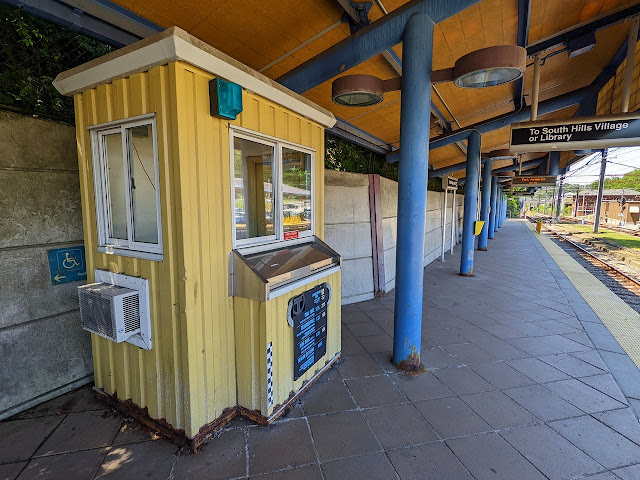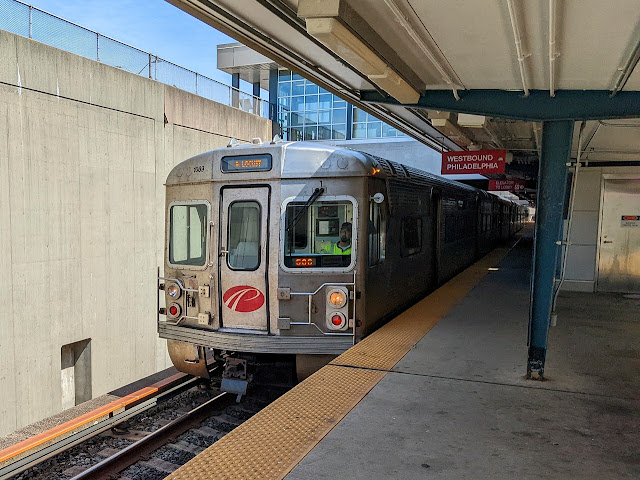My journey begins at Wood St station in Pittsburgh's Light Rail Subway that runs from the north side of the Allegheny River and through downtown. Here a Siemens SD400 type LRV passes through the crossover south of the station. My outbound trip would be provided by LRV #4327.
In the mid-1980's PAT made use of the old PRR Panhandle Route west of Pennsylvania Station to replace its downtown street trackage with a trolley tunnel. The Panhandle Route connected Pittsburgh to Chicago via Columbus and Logansport as opposed to the northerly route via Fort Wayne and exited Penn Station via a tunnel under downtown that would form the nucleus of the current PAT light rail subway. Here we see PAT LRV #4325 on a 47L routing heading inbound at the 1st Ave station. 1st Ave was an infill station built in the early 2000's to in part serve the redeveloped footprint of the former B&O a href="https://en.wikipedia.org/wiki/Grant_Street_Station">Grant Street Station .
The Panhandle Bridge was built for the PRR's Panhandle Route and could support all manner of heavy main line railroad trains. Today the steel truss bridge is barely breaking a sweat with the LRV's that now cross it. Reuse of the disused railroad infrastructure allowed the Smithfield St Bridge used by the PCC's exiting the transit tunnel, to be rebuilt in 1994-95.
PAT Siemens SD400 LRV #4249 at Station Square. PAT received two batches of SD400 pattern high floor LRV's. The first 55 were built by Siemens in the mid-80's to go along with the downtown tunnel project. A second order of 28, numbered in the 4300 series, was built under license by CAF in 2003-4. Travel in the downtown part of the system was historically free with Station Square being the first point that would trigger a fare. This arrangement made trains pay as you enter towards downtown and pay as you exit heading away from downtown.
The Mount Washington Transit Tunnel, along with the large amount of dedicated right of way, is what prevented full bustitution of the Pittsburgh light rail system. Built in 1902, the 3,500 foot tunnel was necessary to get streetcars past the imposing Mouth Washington on the south bank of the Monongahela River. The southern end of the tunnel empties out into South Hills Jct where the routes 42, 47 and 52 all meet.
Also known as the Overbrook Line, the Route 47 ran on a dedicated right of way between South Hills Jct and Overbrook Jct. Although it was a completely dedicated right of way, it was built to classic streetcar/interurban standards with a single track, short passing sidings and wooden trestles over the rivers and roads of the valley. Not rebuilt in the first wave that brought in the LRV's, the 47 saw PCC operation until 1993 when the shut the whole thing down due to poor structural integrity of the trestles. The line would not reopen until 2004 having been completely rebuilt to modern light rail standards with cab signaling, double track and full high level boarding. Below is Boggs station, just past the point where new flyover ramps were built to join the Route 42, replacing the original alignment that used the at-grade crossovers at South Hills Jct.
CAF built SD400 #4301 near Boggs. The 2004 28 car supplementary order was to ultimately replace the Overbrook Line PCCs that were retired without replacement in 1993.
SD400 #4252 near Killarney. Despite being modern, the new Route 47 has little of the charm of the classic Route 47.
Overbrook Jct is where the Routes 42 and 47 merge into a single trunk line. Between 1993 and 2004 all light rail traffic would diverge to the left down the Route 42.
At Washington Jct the 47L branch to Library splits from the 42S and 47S routes to South Hills Village. Here LRV #4206 on a 47S routing meets LRV #4327 on its way to Library.
The old fare system combined with on board payment resulted in some rather unique operating practices. During peak periods when two cars were used, PAT made use of on-platform farebooths at designated two car stations to avoid running trains with fare collectors in the rear car. Anyone riding in the second car would be limited to alighting at two car stations. The use of a timed pass system with unlimited transfers appears to have reduced the need for the platform booths, however i am not sure if PAT has gone full Proof of Payment.
While at Washington Jct transferring to a South Hills Village train, a witnesses LRV #4223 making a relay move at the pocket track south of the station. As the yard is on the South Hills branch, deadheads to/from Library need to reverse at Washington Jct. Until 1999 PCC's operating on the 47D "Drake" shuttle would make use of a turning loop adjacent to the LRV turnback track. The loop was removed after the end of PCC operations when 47D service was suspended.
Here we see another deadhead LRV, #4237, heading south through Washington Jct. I was out around 3pm when peak period cars were entering service.
Here we see LRV #4317 passing the Caswell stop on the 42S branch to South Hills Village. These low cost small platform stations are unfortunately impossible to build any more due to the ADA and the mindset that more is better with Federal funds are available.
The South Hills Village complex, built new in the 1980's, included both an LRV maintenance facility as well as a sizable parking structure and direct access to the South Hills mall. The station has its own farebooth and the platforms are within fare control.
47S LRV #4254 departing South Hills village. All signaling on the system is provided by "local" supplier Union Switch and Signal, that was headquartered in Swissvale, PA.
Catching a Route 42 at South Hills, I alighted at Overbrook Jct to get some photos before transferring to a Route 47. Here LRC #4303 is seen heading towards downtown on the Beechview route.
The timing worked out so that I was there for the next outbound Route 42 with LRV #4249.
The Route 47 station at Overbrook Jct is actually called "Willow" and here we see PAT's CAF class car, #4301, arriving. Although very similar there are some differences with the CAF built SD400's such as the integrated headlight.
My inbound train would be courtesy of SD400 LRV #4226.
As on my outbound trip there were two meets during my inbound trip. These were #4252 at Killarney and #4206 at Boggs.
The double scissors crossover at South Hills Jct actually served more of a purpose when built around 1985 as Route 47 Overbrook Line trains would use the second set of platforms and related ramp to access its historic grade separated right of way. When the 47 reopened in 2004, the conflicting routes at South Hills Jct were largely eliminated via a new flying junction south of the old at-grade jct. The old OVerbrook Line platforms were used for a time by the Route 52 Allentown, but this service was discontinued in 2011 with the tracks only used occasionally as a bypass if the Mt. Washington Tunnel is closed.
Here is a rear view from #4227 as it proceeds from Station Square to 1st Ave over the former PRR Panhaldle Bridge. The junction coming in from the left is where the Route 52 branches off to proceed over Mount Washington to South Hills Jct.
Here #4227 arrives at the Steel Plaza subway station. Steel Plaza actually features a second pair of tracks and platforms used by the Penn Station branch that follows the old Panhandle Tunnel alignment. Anticipating either expanded Amtrak Service or commuter rail over the former PRR Main Line, the single station spur never saw regular service before being shut completely except for special events or disruptions.
Here #4227 arrives at the Steel Plaza subway station. Steel Plaza actually features a second pair of tracks and platforms used by the Penn Station branch that follows the old Panhandle Tunnel alignment. Anticipating either expanded Amtrak Service or commuter rail over the former PRR Main Line, the single station spur never saw regular service before being shut completely except for special events or disruptions.
Another relic of the past at Steel Plaza and many other stations are low level platforms to accommodate the PCC trolleys that were in service between the completion of the downtown tunnel in 1985 and the closure of the Overbrook Line in 1993 and Drake branch in 1999.
Steel Plaza is named for the adjacent US Steel Tower, headquarters of US Steel.
Of course I did get some mainline railroad photos. Here Carload Express SD60M's #6003 and #6005 are seen here in service with the Allegheny Valley Railroad running a train over the NS Pittsburgh Line to the interchange at Penn Ave Yard. Both units are former Conrail engines later owned by NS and abruptly sold off in a 2019 PSR inspired fire sale of equipment. By 2023 NS would be facing persistent equipment shortages, having to lease SD70MAC's to plug the gap. Carload Express is the new name for the shortline holding company that owns both the Allegheny Valley Railroad and Delmarva Central.
Included in this set are some photos of a quick Amtrak trip to Philly for the July 4th holiday. Here Amtrak ACS-86 #624 arrives at the BWI Airport Rail Station with a northbound Regional.
Here are rebuilt PATCO cars #1085 at 15-16th Locust and #1089 at Haddonfield.
Finally Amtrak ACS-86 #645 at 30th St.
Thanks for reading, I'll be back next time with my 2022 trip to Gainesville, GA via Amtrak Train 19, 79 and 20.




































No comments:
Post a Comment